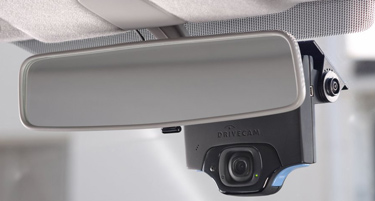
Effective Jan. 1, a new California law will allow video cameras to be mounted on vehicle windshields. (Photo: DriveCam)
Smile at the windshield - and say cheese?
California is giving the green light to allowing video cameras to be mounted onto vehicle windshields in an attempt to improve road safety.
The goal is to make participants aware of bad habits by recording their behavior seconds before and after a crash or erratic driving maneuver.
"It seemed like a common-sense approach," Assemblyman Nathan Fletcher said of permitting but not requiring the use of video recorders.
Parents could buy such cameras to place in their teenager's car, but the prime market is expected to be truck, bus or other transportation companies with large fleets.
Critics question whether expanding workplace recording intrudes upon privacy in a society where cameras already are used for purposes ranging from monitoring department store aisles to detecting red-light violations.
"We have this fundamental right to privacy, and I don't think there was a case made for why we need to have continuous recording of drivers and traffic," said Valerie Small Navarro of the American Civil Liberties Union.
The issue comes at a time when the country is split on another matter pitting privacy concerns against public safety policy - full-body scans and aggressive pat-downs at airports.
California's new recording law, Assembly Bill 1942, will allow cameras to be mounted on windshields beginning Jan. 1, much as electronic GPS mapping and toll-paying devices are permitted now.
Fletcher, R-San Diego, carried AB 1942 on behalf of a company in his district that produces vehicle cameras, DriveCam, but competing firms exist nationwide, he said.
DriveCam's camera simultaneously records actions inside a vehicle - by the driver or passengers - and any traffic movement in lanes directly in front of the windshield.
The camera continuously records audio and video but saves images only from eight seconds before and four seconds after a crash or erratic motion, like a sudden stop, acceleration or swerve. Images of any event are uploaded to DriveCam, analyzed, and then posted to a secure website.
Recordings can be used as evidence of fault in traffic collisions.
Tool for driver education
They also can help eliminate bad driving habits: By analyzing events leading up to a collision or near miss, fleet managers and parents can coach safer driving, said Eric Cohen of DriveCam.
DriveCam points to a study by the Federal Motor Carrier Safety Administration that found cameras reduced the number of collisions or risky maneuvers per miles driven by 37 percent and 52 percent, respectively, in two groups of truck drivers tested.
Families can buy a windshield camera from DriveCam for about $900, including one year of monitoring during which the firm collects all recordings and provides an analysis to clients for coaching purposes, Cohen said.
DriveCam has joined forces with American Family Insurance in a 19-state program, not available in California, which offers a free vehicle camera to families in which a teenager recently received a driver's license.
Nationally, DriveCam has equipped 150,000 vehicles with recording devices. Prior to AB 1942, California did not outlaw such cameras but barred their placement on windshields, the prime spot for recording.
Fletcher said he tried to narrow privacy concerns by amending AB 1942 to allow no more than 30 seconds of recordings to be retained per incident, to require a posted notice for passengers that talking may be recorded, and to ensure that owners of participating vehicles can disable cameras and employee drivers can obtain recordings.
"If you have a technology that's been demonstrated to reduce accidents, and you can allow its use in a way that safeguards privacy, you should do it," Fletcher said.
Because AB 1942 allows recordings to be examined only if there is a crash or erratic motion, the cameras cannot be used to routinely check whether radios are blaring or drivers are talking on cell phones.
Bad precedent feared
Nonetheless, society should think twice about continuous on-the-job video recording of employees, says Small Navarro of the ACLU.
"What is our reasonable expectation of privacy in the workplace?" she asked.
For union employees, use of recording devices would be subject to collective bargaining, Fletcher noted.
But former Republican legislator Tim Leslie said allowing continuous video recording inside vehicles sets a sobering precedent.
"Are we going to be filmed all the time, in a few years, or what?" he asked.
"Big Brother does not need to land on my dashboard," added Assemblywoman Mariko Yamada, D-Davis.
Assemblyman Jared Huffman, D-San Rafael, said that cameras might be acceptable in buses, taxis and other forms of mass transit, but that allowing them in all vehicles could be a "slippery slope to major privacy invasions."
Fletcher said the new law seeks to enhance traffic safety, not weaken privacy rights.
"We made it very focused and very narrow for a specific purpose," Fletcher said.
Several truckers interviewed at a West Sacramento truck stop gave thumbs-up to cameras, saying their value in documenting collisions outweighs privacy concerns.
"Hopefully, it will save on the insurance," said Gordon Ohta, 52, of Sacramento.
"I always feel that it you don't have anything to hide and it improves safety, that's the way to go," said Hans Plesman, 48, of Atherton.











